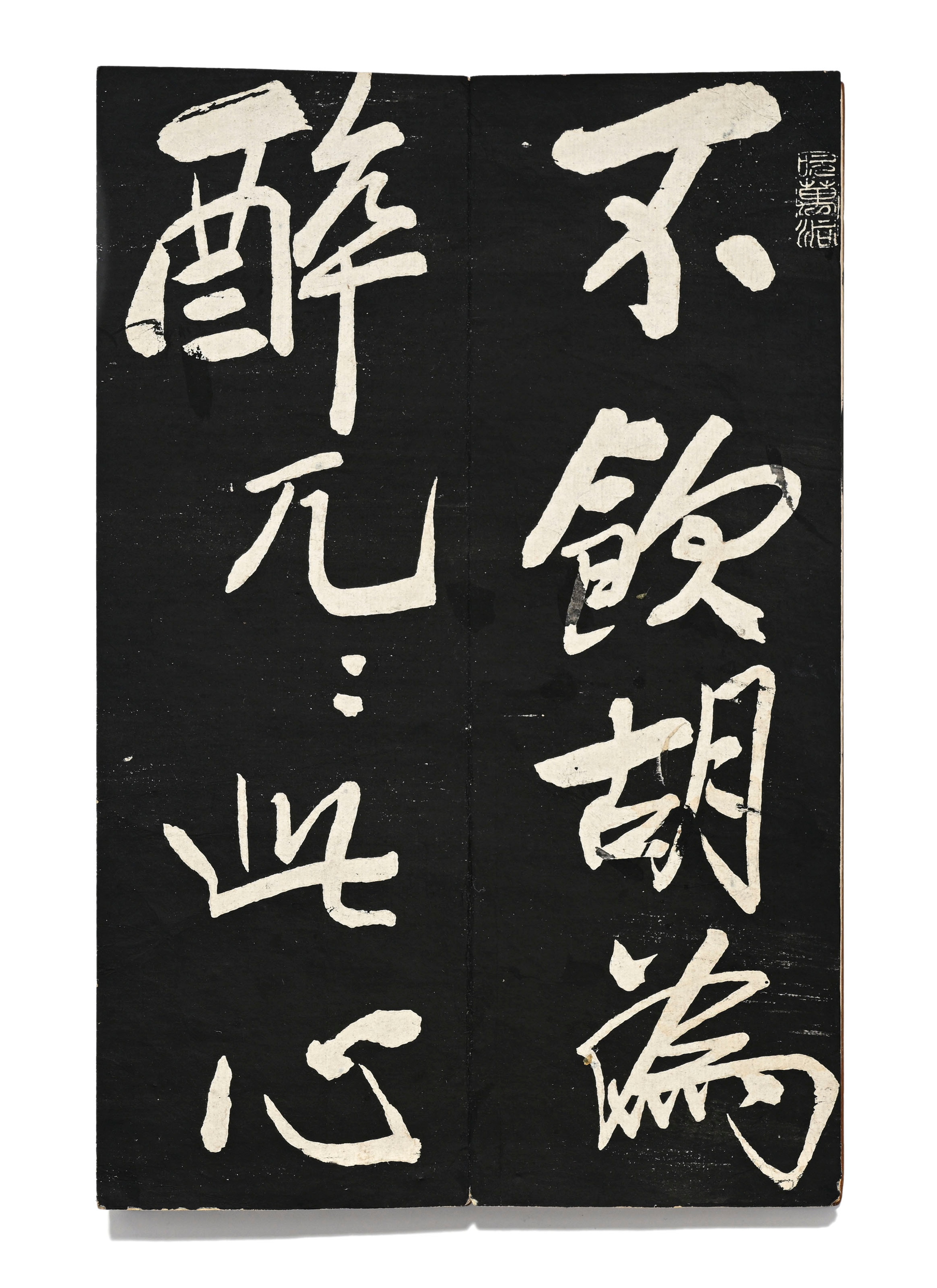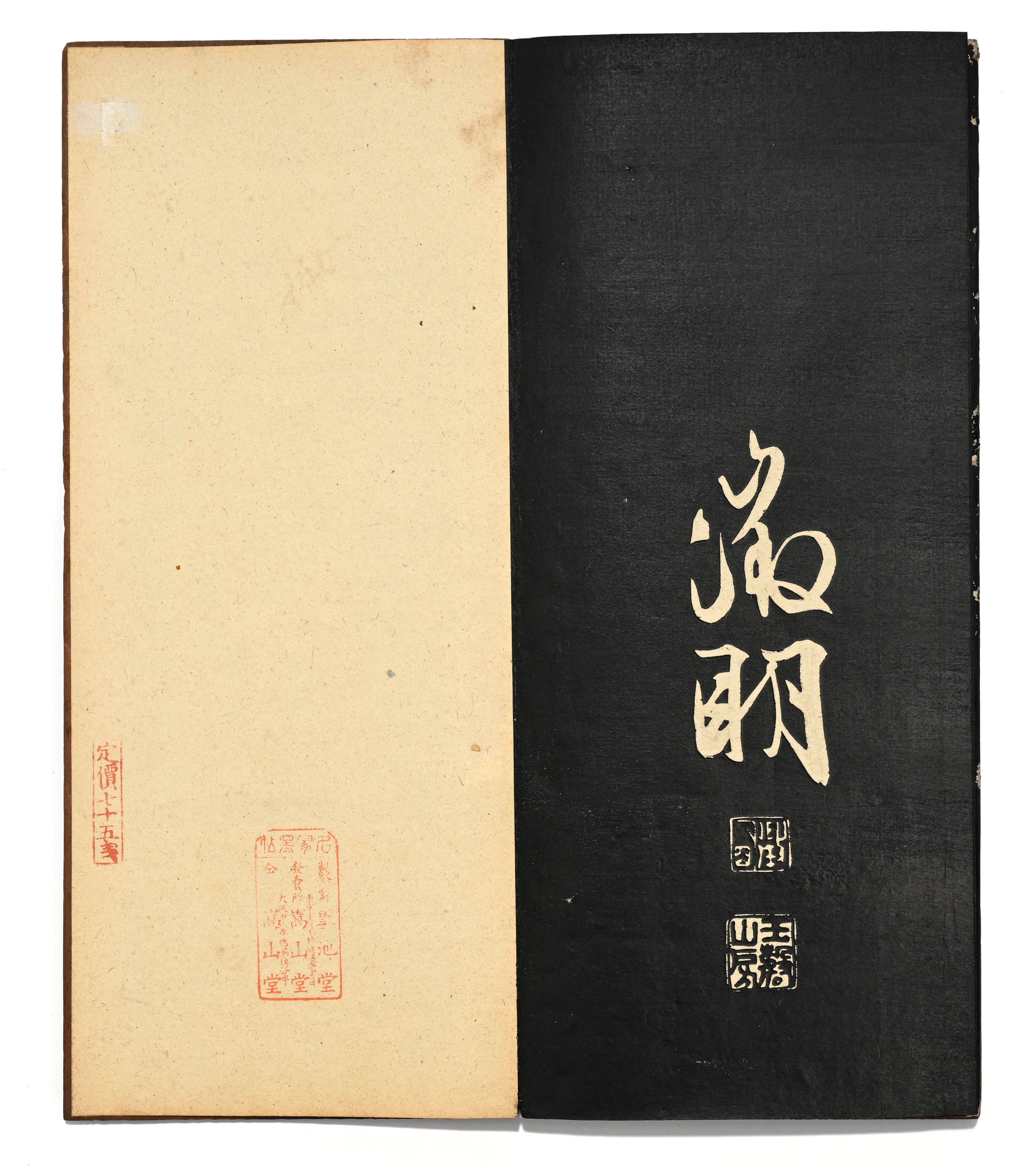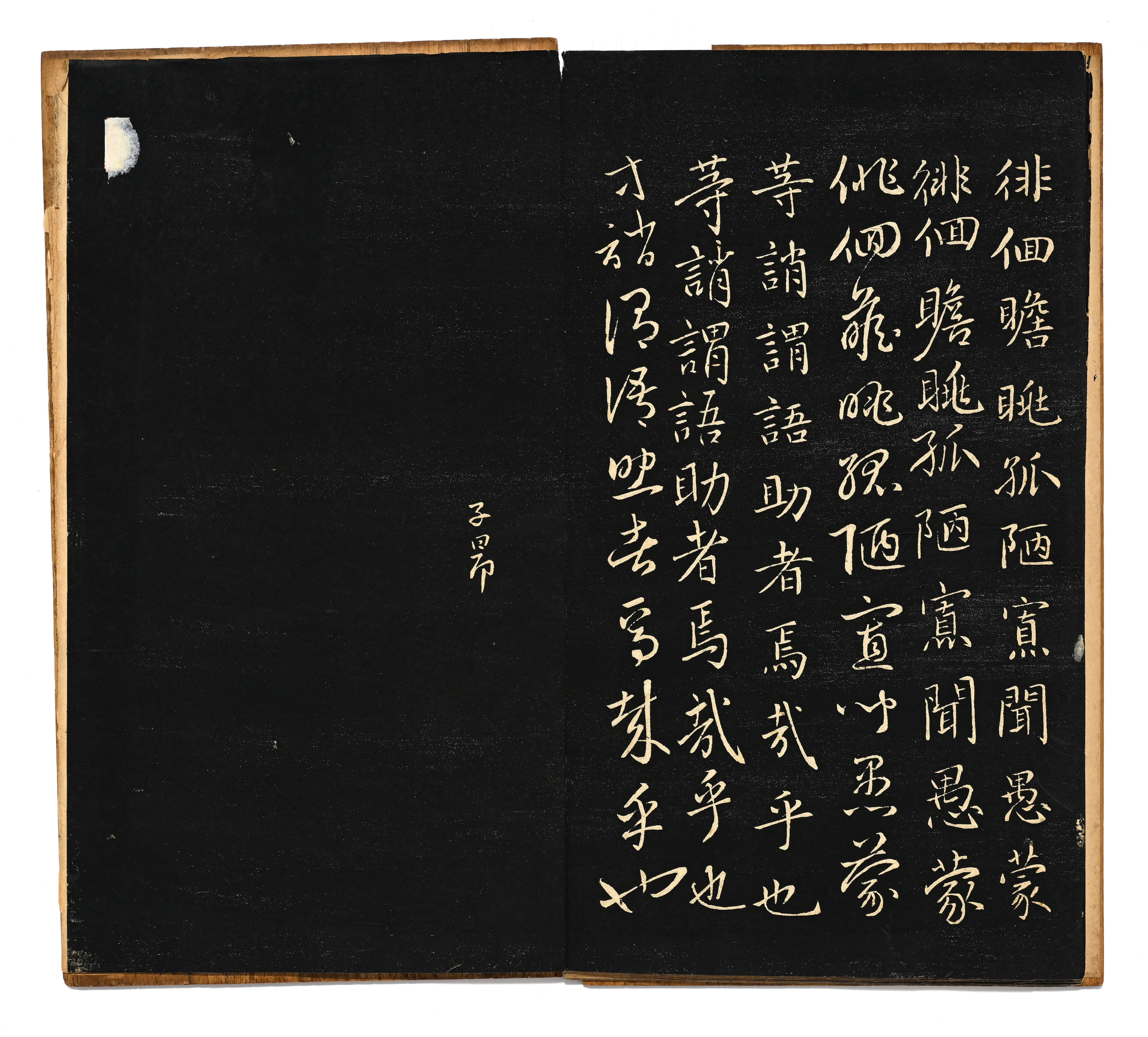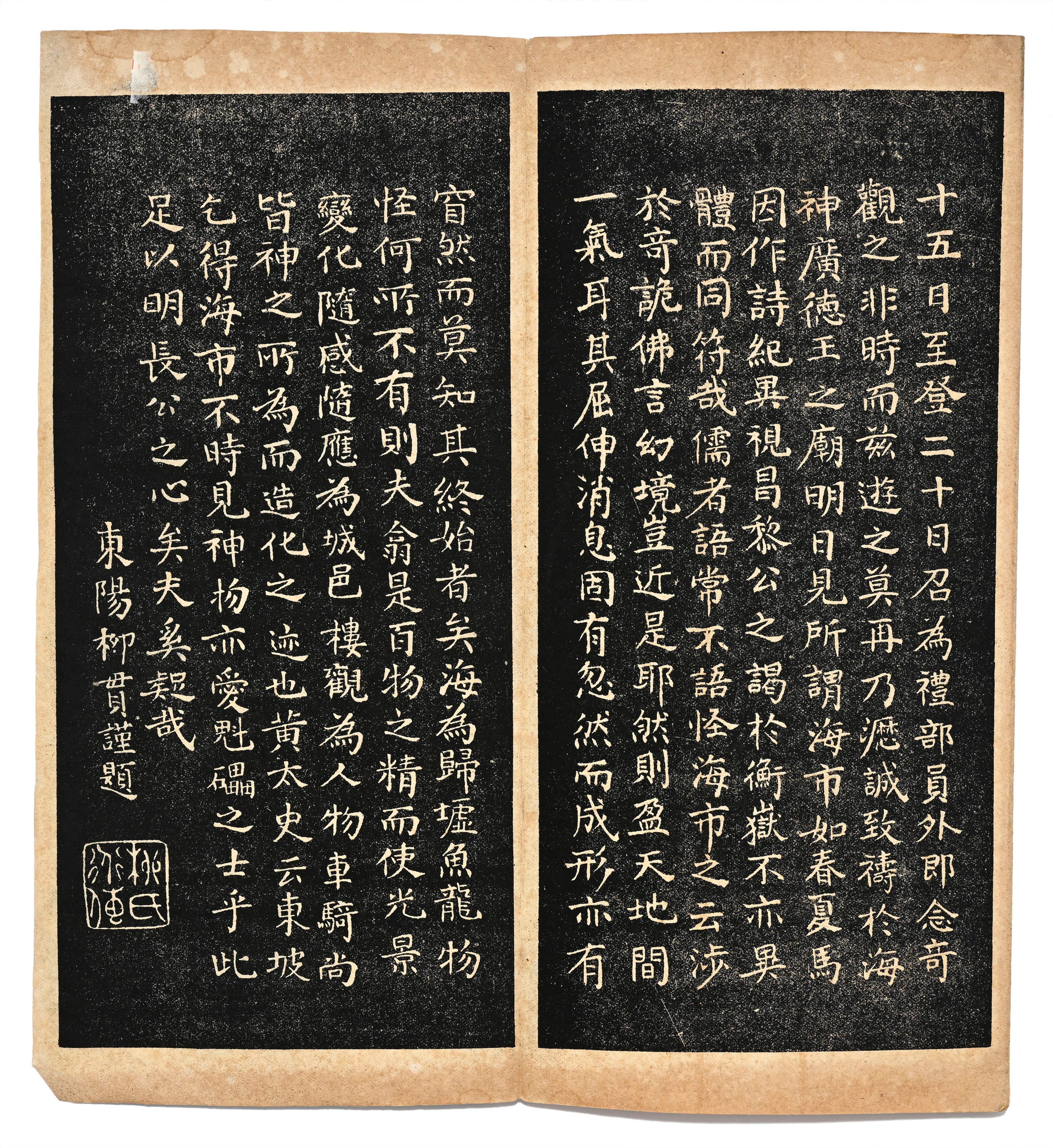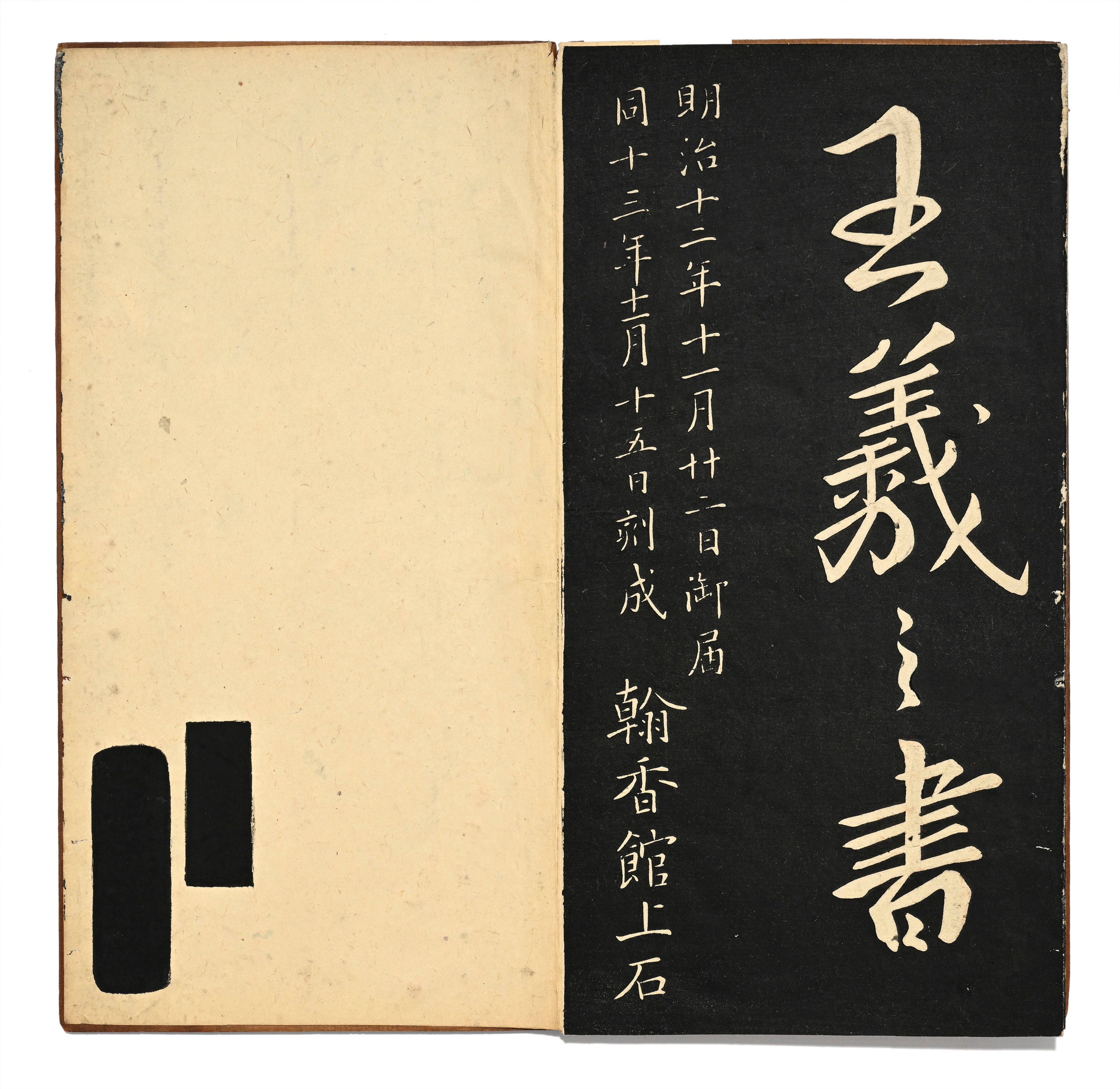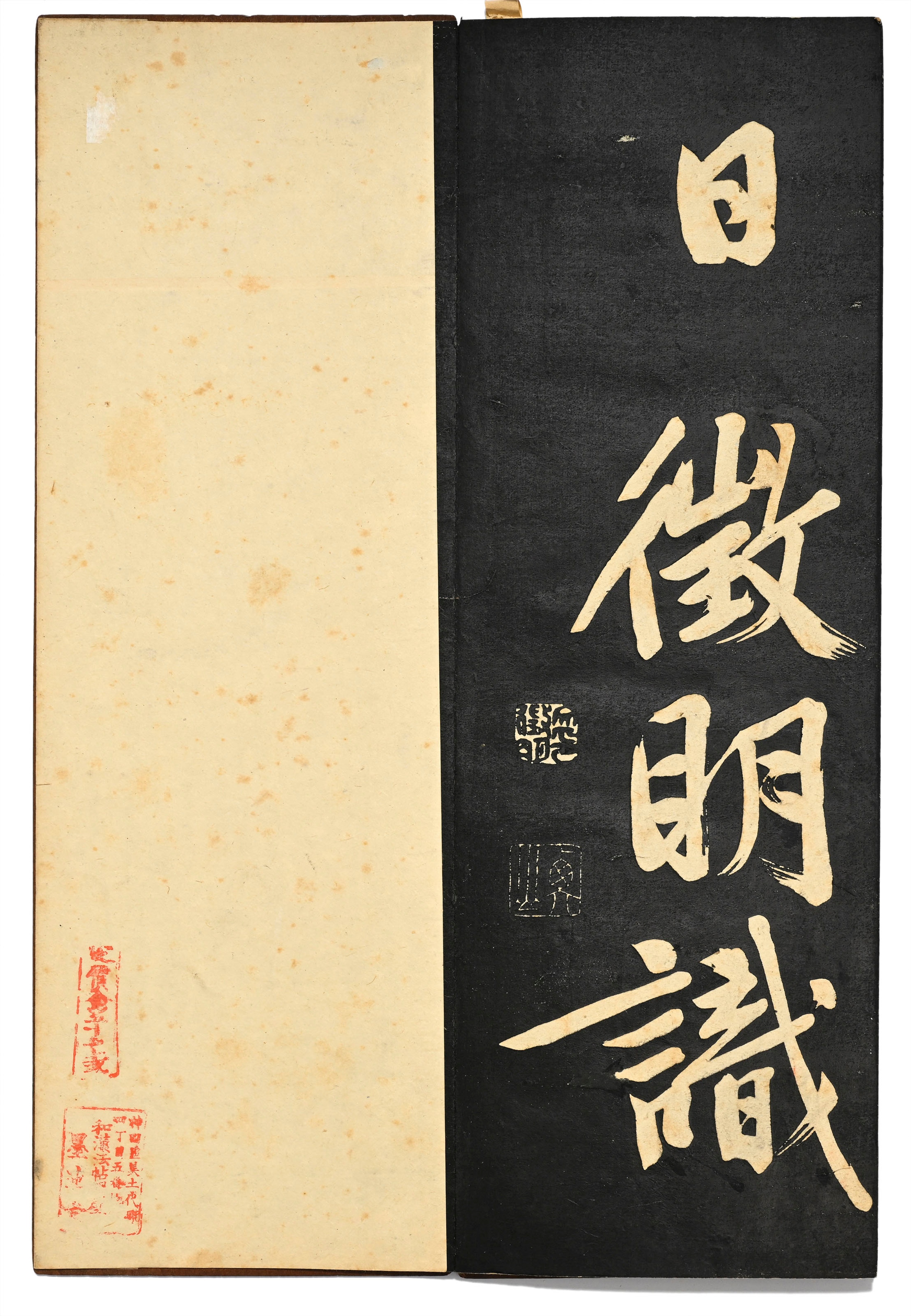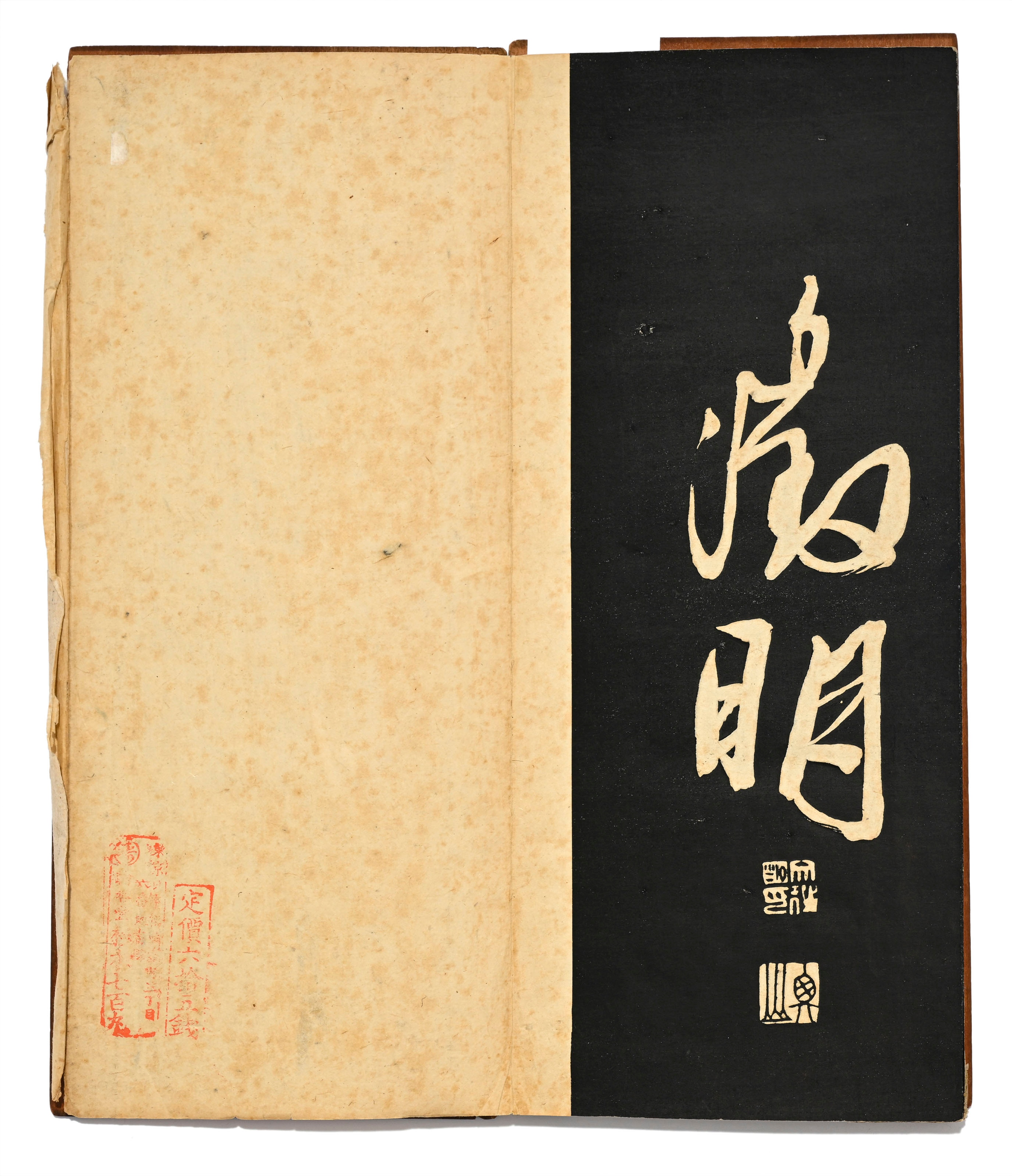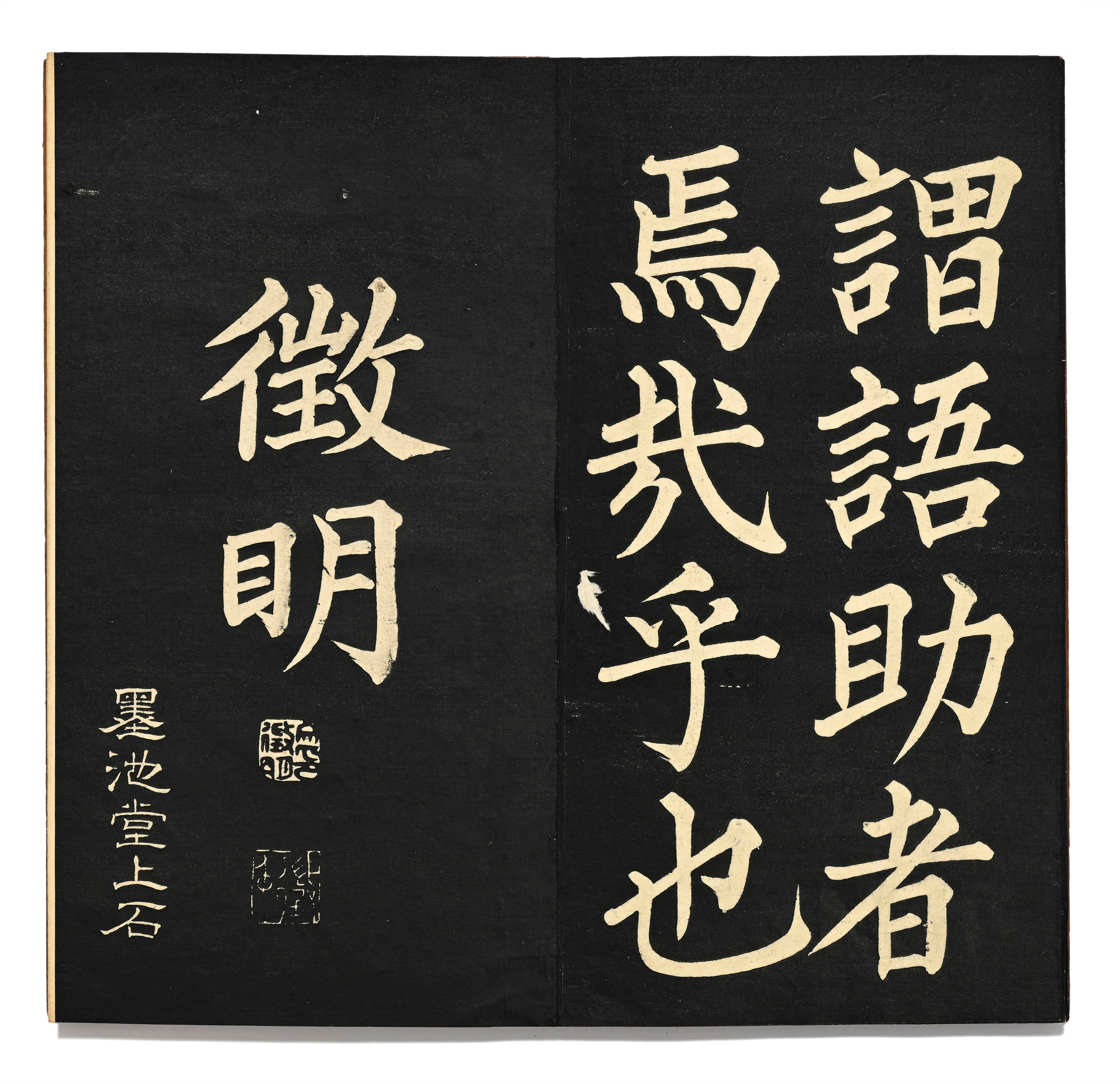1643
Ensemble de 9 albums leporello de calligraphies sur fond noir, Chine et Japon, XIX-XXe s., dont 8 en
Ensemble de 9 albums leporello de calligraphies sur fond noir, Chine et Japon, XIX-XXe s., dont 8 en papier frotté avec couverture et dos en bois et 1 d'estampes, tailles diverses (restaurations), comprenant:
- 1 en papier frotté intitulé 趙子昌三体千字文 (“Le classique des mille caractères en trois styles par Zhao Zichang”)
- 1 d'estampes intitulé 蘇學士大字法書 ("La grande calligraphie de Su Xueshi")
- 1en papier frotté intitulé 真書千字文 ("Le classique des mille caractères"), sous-titre 文徵明 書 ("Calligraphié par Wen Zhenming"), sceaux à la fin de l'ouvrage
- 2 en papier frotté intitulés 東坡先生詩 ("Les poèmes de Monsieur Dongpo"), sous-titre 柴 秋邨 先生 書 ("Calligraphié par Shiba Shunson")
- 1 en papier frotté intitulé 草書 前赤壁賦 (“Écrit de la falaise rouge”), sous-titre 文徵明書 (“Calligraphié par Wen Zhengming”) , deux sceaux à la fin de l'ouvrage
- 3 en papier frotté sans titre inscrit sur les couvertures en bois, dont 1 daté de la 12e année de la période Meiji (1879), et 2 avec sceaux rouges
Provenance: collection Li Ai Vee (1932-2021), chalet Yu-Lan
A set of 9 leporello albums of calligraphy on black background, China and Japan, 19th-20th century, including 8 in rubbed paper with wooden cover and back and 1 of prints, various sizes (restorations), comprising:
- 1 in rubbed paper entitled 趙子昌三体千字文 (‘The Thousand Character Classic in three styles by Zhao Zichang’)
- 1 of prints entitled 蘇學士大字法書 (‘The great calligraphy of Su Xueshi’)
- 1 in rubbed paper entitled 真書千字文 (‘The Thousand Character Classic’), subtitle 文徵明 書 (‘Calligraphy by Wen Zhenming’), seals at the end of the book
- 2 in rubbed paper entitled 東坡先生詩 (‘Mr Dongpo's poems’), subtitle 柴 秋邨 先生 書 (‘Calligraphy by Shiba Shunson’)
- 1 in rubbed paper titled 草書 前赤壁賦 (‘Written from the red cliff’), subtitle 文徵明書 (‘Calligraphied by Wen Zhengming’), two seals at the end of the work
- 3 in rubbed paper without titles inscribed on the wooden covers, including 1 dated the 12th year of the Meiji period (1879), and 2 with red seals
Provenance: Li Ai Vee collection (1932-2021), Yu-Lan chalet
九冊書法冊,中國和日本,十九世紀到二十世紀
八冊拓片冊,一冊版畫冊
已經過修復
來自李愛維收藏 (1932-2021), 玉蘭木屋
Condition
Usure générale des surfaces
Déchirures
Taches
Plis
Trous
Rayures de surface
Restaurations
Certaines plaques en bois ne tiennent plus très bien, d'autres ne sont pas solidaires à la partie en papier
Overall wear to the surfaces
Tears
Stains
Folds
Holes
Surface scratches
Restorations
Some of the wooden covers and backs do not hold very well, others are not attached to the paper part
Provenance
La Maison Piguet est honorée de vous présenter la troisième partie de la collection de Madame Li Ai Vee (李爱维, née Eva Anita Li, 1932-2021), peintre sino-allemande établie en Suisse et fervente collectionneuse d’art asiatique, principalement chinois et japonais.
Née à Shanghai, Li Ai Vee, initiée dès l’enfance à la peinture par sa mère elle-même artiste, devient ensuite l’élève de prestigieux peintres, à savoir Lin Fengmian (1900-1991) et Lu Yifei (1908-1997) dans les années 50. Elle séjourne ensuite quelques années au Japon, où elle fut disciple du maître zen Rinzai Yamada Mumon Rôshi (1900-1988). Là-bas, elle fut sélectionnée en 1954 pour exécuter des peintures de bambou sur les portes coulissantes du Mémorial d’Hiroshima.
En 1958, Li Ai Vee quitte la Chine et s’installe en Suisse, à Zurich. En 1965, elle reçoit la médaille de la Ville de Paris, en reconnaissance de son art. Elle rencontre Zhang Daqian (Chang Dai-Chien, 1899-1983) la même année, et devient l’élève de ce peintre internationalement connu.
En 1973, Li Ai Vee s’installe à Blonay dans le chalet “Yu-Lan” (玉蘭, “Magnolia”), chalet entouré d’une vaste forêt de bambous et gardé par des chiens de Fô sculptés. C’est là-bas qu’elle peint, entourée de son importante collection d’art asiatique qu’elle étoffe au fil des années. Li Ai Vee a su rassembler un ensemble d’objets riche et varié mêlant vases monochromes, peintures et albums, objets de lettrés, jades sculptés et divinités du panthéon asiatique, le tout côtoyant en toute harmonie ses propres peintures.
L’entièreté de la collection peut être retrouvée en indiquant sur notre site le mot-clé “Li Ai Vee” dans la barre de recherche
La suite des objets de Li Ai Vee seront présentés dans notre future vente de juin 2025.
Piguet auction house is honoured to present the third part of the collection of Li Ai Vee (李爱维, born Eva Anita Li, 1932-2021), a Chinese-German painter living in Switzerland and a fervent collector of Asian art, mainly Chinese and Japanese.
Born in Shanghai, Li Ai Vee was introduced to painting as a child by her mother, herself an artist, and went on to become a pupil of prestigious painters such as Lin Fengmian (1900-1991) and Lu Yifei (1908-1997) in the 1950s. She then spent several years in Japan, where she was a disciple of the Zen master Rinzai Yamada Mumon Rôshi (1900-1988). There, in 1954, she was selected to paint several bamboos on the sliding doors of the Hiroshima Memorial.
In 1958, Li Ai Vee left China and settled in Zurich, Switzerland. In 1965, she met Zhang Daqian (Chang Dai-Chien, 1899-1983), and became a pupil of this internationally renowned painter. That same year, she was awarded the Medal of the City of Paris in recognition of her art.
In 1973, Li Ai Vee moved to Blonay to the chalet ‘Yu-Lan’ ( 玉蘭 , ‘Magnolia’), surrounded by a vast bamboo forest and guarded by carved Foo lions. It was there that she painted, surrounded by her extensive collection of Asian art, which she has enriched over the years. Li Ai Vee has put together a rich and varied collection of objects, combining monochrome vases, paintings and albums, scholarly objects, carved jades and divinities from the Asian pantheon, all of which she has combined with her passion for art.
The entire collection can be found by entering the keyword ‘Li Ai Vee’ in the search bar on our website.
The third and fourth parts of Li Ai Vee's collection will be presented in our future sale in June 2025.
Ensemble de 9 albums leporello de calligraphies sur fond noir, Chine et Japon, XIX-XXe s., dont 8 en papier frotté avec couverture et dos en bois et 1 d'estampes, tailles diverses (restaurations), comprenant:
- 1 en papier frotté intitulé 趙子昌三体千字文 (“Le classique des mille caractères en trois styles par Zhao Zichang”)
- 1 d'estampes intitulé 蘇學士大字法書 ("La grande calligraphie de Su Xueshi")
- 1en papier frotté intitulé 真書千字文 ("Le classique des mille caractères"), sous-titre 文徵明 書 ("Calligraphié par Wen Zhenming"), sceaux à la fin de l'ouvrage
- 2 en papier frotté intitulés 東坡先生詩 ("Les poèmes de Monsieur Dongpo"), sous-titre 柴 秋邨 先生 書 ("Calligraphié par Shiba Shunson")
- 1 en papier frotté intitulé 草書 前赤壁賦 (“Écrit de la falaise rouge”), sous-titre 文徵明書 (“Calligraphié par Wen Zhengming”) , deux sceaux à la fin de l'ouvrage
- 3 en papier frotté sans titre inscrit sur les couvertures en bois, dont 1 daté de la 12e année de la période Meiji (1879), et 2 avec sceaux rouges
Provenance: collection Li Ai Vee (1932-2021), chalet Yu-Lan
A set of 9 leporello albums of calligraphy on black background, China and Japan, 19th-20th century, including 8 in rubbed paper with wooden cover and back and 1 of prints, various sizes (restorations), comprising:
- 1 in rubbed paper entitled 趙子昌三体千字文 (‘The Thousand Character Classic in three styles by Zhao Zichang’)
- 1 of prints entitled 蘇學士大字法書 (‘The great calligraphy of Su Xueshi’)
- 1 in rubbed paper entitled 真書千字文 (‘The Thousand Character Classic’), subtitle 文徵明 書 (‘Calligraphy by Wen Zhenming’), seals at the end of the book
- 2 in rubbed paper entitled 東坡先生詩 (‘Mr Dongpo's poems’), subtitle 柴 秋邨 先生 書 (‘Calligraphy by Shiba Shunson’)
- 1 in rubbed paper titled 草書 前赤壁賦 (‘Written from the red cliff’), subtitle 文徵明書 (‘Calligraphied by Wen Zhengming’), two seals at the end of the work
- 3 in rubbed paper without titles inscribed on the wooden covers, including 1 dated the 12th year of the Meiji period (1879), and 2 with red seals
Provenance: Li Ai Vee collection (1932-2021), Yu-Lan chalet
九冊書法冊,中國和日本,十九世紀到二十世紀
八冊拓片冊,一冊版畫冊
已經過修復
來自李愛維收藏 (1932-2021), 玉蘭木屋
Condition
Usure générale des surfaces
Déchirures
Taches
Plis
Trous
Rayures de surface
Restaurations
Certaines plaques en bois ne tiennent plus très bien, d'autres ne sont pas solidaires à la partie en papier
Overall wear to the surfaces
Tears
Stains
Folds
Holes
Surface scratches
Restorations
Some of the wooden covers and backs do not hold very well, others are not attached to the paper part
Provenance
La Maison Piguet est honorée de vous présenter la troisième partie de la collection de Madame Li Ai Vee (李爱维, née Eva Anita Li, 1932-2021), peintre sino-allemande établie en Suisse et fervente collectionneuse d’art asiatique, principalement chinois et japonais.
Née à Shanghai, Li Ai Vee, initiée dès l’enfance à la peinture par sa mère elle-même artiste, devient ensuite l’élève de prestigieux peintres, à savoir Lin Fengmian (1900-1991) et Lu Yifei (1908-1997) dans les années 50. Elle séjourne ensuite quelques années au Japon, où elle fut disciple du maître zen Rinzai Yamada Mumon Rôshi (1900-1988). Là-bas, elle fut sélectionnée en 1954 pour exécuter des peintures de bambou sur les portes coulissantes du Mémorial d’Hiroshima.
En 1958, Li Ai Vee quitte la Chine et s’installe en Suisse, à Zurich. En 1965, elle reçoit la médaille de la Ville de Paris, en reconnaissance de son art. Elle rencontre Zhang Daqian (Chang Dai-Chien, 1899-1983) la même année, et devient l’élève de ce peintre internationalement connu.
En 1973, Li Ai Vee s’installe à Blonay dans le chalet “Yu-Lan” (玉蘭, “Magnolia”), chalet entouré d’une vaste forêt de bambous et gardé par des chiens de Fô sculptés. C’est là-bas qu’elle peint, entourée de son importante collection d’art asiatique qu’elle étoffe au fil des années. Li Ai Vee a su rassembler un ensemble d’objets riche et varié mêlant vases monochromes, peintures et albums, objets de lettrés, jades sculptés et divinités du panthéon asiatique, le tout côtoyant en toute harmonie ses propres peintures.
L’entièreté de la collection peut être retrouvée en indiquant sur notre site le mot-clé “Li Ai Vee” dans la barre de recherche
La suite des objets de Li Ai Vee seront présentés dans notre future vente de juin 2025.
Piguet auction house is honoured to present the third part of the collection of Li Ai Vee (李爱维, born Eva Anita Li, 1932-2021), a Chinese-German painter living in Switzerland and a fervent collector of Asian art, mainly Chinese and Japanese.
Born in Shanghai, Li Ai Vee was introduced to painting as a child by her mother, herself an artist, and went on to become a pupil of prestigious painters such as Lin Fengmian (1900-1991) and Lu Yifei (1908-1997) in the 1950s. She then spent several years in Japan, where she was a disciple of the Zen master Rinzai Yamada Mumon Rôshi (1900-1988). There, in 1954, she was selected to paint several bamboos on the sliding doors of the Hiroshima Memorial.
In 1958, Li Ai Vee left China and settled in Zurich, Switzerland. In 1965, she met Zhang Daqian (Chang Dai-Chien, 1899-1983), and became a pupil of this internationally renowned painter. That same year, she was awarded the Medal of the City of Paris in recognition of her art.
In 1973, Li Ai Vee moved to Blonay to the chalet ‘Yu-Lan’ ( 玉蘭 , ‘Magnolia’), surrounded by a vast bamboo forest and guarded by carved Foo lions. It was there that she painted, surrounded by her extensive collection of Asian art, which she has enriched over the years. Li Ai Vee has put together a rich and varied collection of objects, combining monochrome vases, paintings and albums, scholarly objects, carved jades and divinities from the Asian pantheon, all of which she has combined with her passion for art.
The entire collection can be found by entering the keyword ‘Li Ai Vee’ in the search bar on our website.
The third and fourth parts of Li Ai Vee's collection will be presented in our future sale in June 2025.
ONLINE (1604 à 1827) - Arts d'Orient
Ends from
Venue Address
Important Information
REMISE DES LOTS : Vendredi 21 mars - 11h - 17h Samedi 22 mars - 10h - 14h Lundi 24 mars - 11h - 17h




























